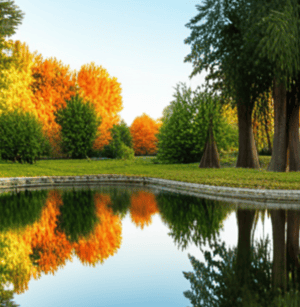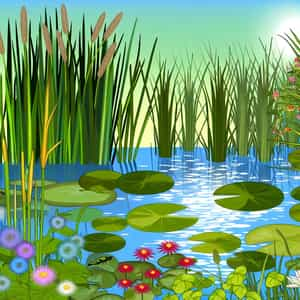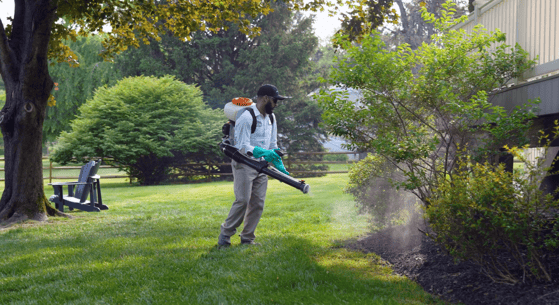How To Control Mosquitos in Ponds
A Homeowner's Guide to a Tranquil Haven
Mosquitoes can quickly turn a serene backyard pond into a buzzing, biting hotspot. For homeowners looking to enjoy their outdoor spaces without the nuisance and potential health risks of these pesky insects, understanding mosquito control in ponds is crucial. This comprehensive guide will walk you through everything you need to know to manage mosquito populations in your pond, from natural approaches to chemical solutions and essential maintenance tips.
Understanding the Threat: Mosquitoes in Ponds
 Before we tackle control methods, it's important to know your enemy. Mosquitoes are not only a persistent irritation but also pose significant health risks. They are known carriers of various diseases, including malaria, dengue fever, and the West Nile virus. In a residential setting, ponds can become a prime mosquito breeding ground due to the stagnant water and aquatic plants that provide shelter for their larvae.
Before we tackle control methods, it's important to know your enemy. Mosquitoes are not only a persistent irritation but also pose significant health risks. They are known carriers of various diseases, including malaria, dengue fever, and the West Nile virus. In a residential setting, ponds can become a prime mosquito breeding ground due to the stagnant water and aquatic plants that provide shelter for their larvae.
The Lifecycle of Mosquitoes
Mosquitoes go through four distinct stages in their life cycle: egg, larva, pupa, and adult. The larval and pupal stages, which take place in water, provide ideal circumstances for management interventions. Knowing when and where to intervene is key to controlling mosquito populations effectively.
Health Risks Associated with Mosquitoes
Understanding the potential health hazards associated with mosquitoes can highlight the urgency of controlling their presence.
Breeding sites, including ponds, present an often-overlooked risk for homeowners and their families.
Natural Mosquito Control Methods For Ponds
For those who prefer to manage their pond without resorting to chemicals, several eco-friendly methods can significantly reduce mosquito populations.
Plant-Based Solutions
Certain plants are natural mosquito repellents and can be strategically placed around your pond to discourage mosquitoes from breeding and gathering.
Introducing Mosquito-Repellent Plants

Plants known for their mosquito-repelling properties, such as citronella, lemongrass, and lavender, can be potted and placed near the pond's edge to create a natural barrier.
Biological Control Options
Incorporating nature's own balance can work wonders. Introducing predators or microbes that target mosquito larvae can offer long-term control.
Introducing Mosquito-Eating Fish
Fish species like the mosquito fish (Gambusia affinis) or certain types of guppies can actively consume mosquito larvae, keeping the population in check.
Eco-friendly methods like introducing mosquito-eating fish can offer long-term mosquito control without harming the pond ecosystem.
Bacterial Larvicides
Products that contain bacteria like Bacillus thuringiensis israelensis (BTI) can be added to the pond water to target only mosquito and black fly larvae, leaving other aquatic life unharmed.
Chemical Treatments for Mosquito Control
When natural means aren't sufficient to manage the mosquito population, targeted chemical treatments can provide an effective solution.
Larvicides and Insect Growth Regulators
These products are designed to act on the larvae stage of mosquitoes, preventing them from maturing into adults.
Disrupting Mosquito Development
Insect growth regulators and some larvicides work by interrupting the normal growth process of mosquito larvae, stopping their development.

Adulticides
For more immediate relief, adulticides can be used to kill adult mosquitoes, though they present a higher risk to non-target insects and the pond ecosystem.
Sprays and Foggers
Spraying the area around the pond or using foggers to apply a fine mist over the water can quickly reduce adult mosquito populations. However, these methods should be used with caution to avoid harming beneficial insects.
Maintenance Tips for Mosquito-Free Ponds
Prevention is often the most efficient form of control. Regular pond maintenance can prevent mosquito breeding and keep the ecosystem balanced.
Removing Standing Water
Standing water, whether in the form of puddles or areas of the pond, is a breeding ground for mosquitoes. Ensuring proper drainage and circulation can eliminate these potential sites.
Pond Aeration and Circulation
Installing fountains, pumps, or aerators can maintain water movement, preventing stagnation and making the environment less hospitable for mosquitoes to lay their eggs.
Integrated Pest Management Strategies
A comprehensive approach to mosquito control is often the most effective. Integrated pest management (IPM) techniques incorporate multiple strategies, tailored to the unique conditions of your pond and surrounding environment.
Monitoring and Surveillance
Regular inspections and monitoring for the presence of mosquito larvae and adults can help you detect and address issues before they become unmanageable.
Don't Dive Into Mosquito Control Uninformed
Mosquito control in ponds is a critical aspect of maintaining a relaxing outdoor space.
By employing the techniques outlined in this guide -- from understanding the mosquito lifecycle to implementing a combination of natural and, if necessary, chemical control measures -- you can ensure that your pond remains a haven of tranquility, free from the buzzing and biting of these troublesome insects.
Always choose methods that are safe for your pond's ecosystem, and remember, a little prevention can go a long way in keeping your pond mosquito-free.
